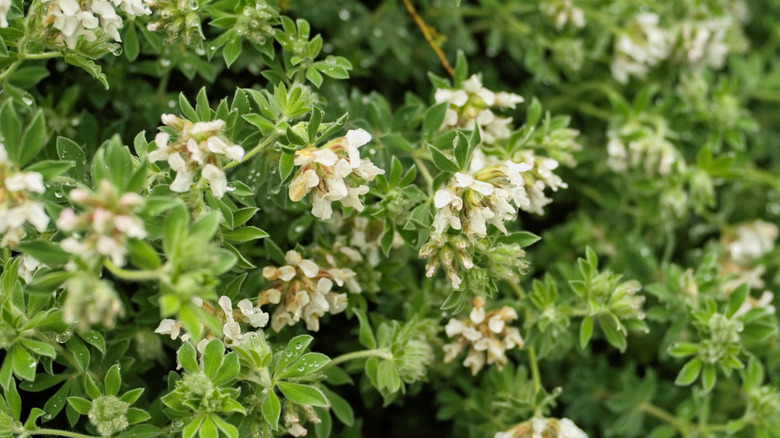The Resilient Ground Cover That Attracts Pollinators With Its Enchanting Blooms
"Hairy Canary" sounds a bit like the name of a character from an '80s cartoon. Instead, it's part of the nickname hairy canary clover, a lovely flowering ground cover also known as Dorycnium hirsutum. These plants have plenty of commendable traits. In fact, this plant is vying to become the latest addition to your landscape. They boast delicate pink and white flowers and silver, hairy leaves. In the fall, hairy canary-clover puts on a show of deep red seed pods. But beauty is only the beginning of this plant's winning features.
Hairy canary clover loves heat and doesn't mind drought. It's not tempting to deer or rabbits, but pollinators — especially bees — find the blossoms irresistible. Add these plants that will thrive without much water to your garden beds, and you'll be doing your part to support your ecosystem's pollinators. Although it's not native to North America, this plant of Mediterranean origin grows slowly and doesn't show signs of becoming invasive. Hairy canary clover grows to heights of about 8 inches to 20 inches, and each plant may reach 3 feet in width.
If you have a sun-drenched spot to fill in your yard, hairy canary clover is ready to move in. In return, you'll get a source of year-round foliage and several months of blooms in late summer and early fall. This evergreen sub-shrub will hold onto its leaves all year, making it a great eco-friendly grass alternative with no mowing or strict watering obligations.
Growing and maintaining hairy canary clover
You'll have your best chances of success with hairy canary clover if you live in USDA zones 8, 9, or 10. However, it is hardy down to 10 degrees Fahrenheit. Along with a sunny locale, it relies on well-draining soil. It's not susceptible to many diseases or pests, but root rot can occur if the soil holds too much moisture. It will grow happiest in soil that's loamy or sandy and neutral or slightly alkaline, but as long as it's not too wet, poor soil quality is no problem for this plant. Hairy canary clover is also a top choice for seaside gardens, since it's resistant to salt and windy conditions.
Space hairy canary clover plants between 2 to 3 feet apart in full sun. Once you've settled your hairy canary clover into the ideal spot, water it twice weekly until it's established. After it's made itself comfortable, you can back off to watering weekly or even less frequently. After it blooms, cutting back hairy canary clover will spur it to produce new foliage, and giving it a good trim in spring will help the plants become bushy and compact.

